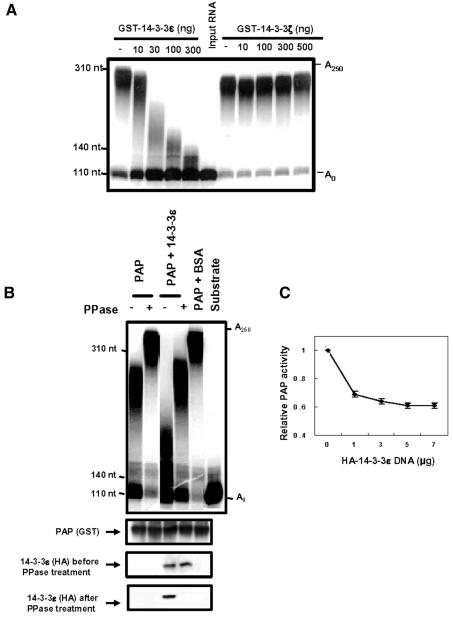Fig. 6. Effects of interaction of poly(A) polymerase (PAP) with 14-3-3ε on non-specific polyadenylation. We performed non-specific polyadenylation assays with His-PAP of GST–PAP. The c-mos mRNA substrate was incubated with His-PAP or GST–PAP in a reaction buffer containing 0.5 mM MnCl2 and [α-32P]ATP. The PAP reaction products were analyzed by electrophoresis on a 5% polyacrylamide gel containing 8 M urea. The c-mos mRNA substrate (S) was labeled at the 3′ end with [32P]pCp and used as a size control. (A) The purified His-PAP was used for non-specific polyadenylation assays in the presence of the indicated amounts of GST–14-3-3ε. GST–14-3-3ζ, which showed no binding to His-PAP (Figure 2), was used as a negative control. (B) GST–PAP was purified from the lysates of NIH 3T3 cells transfected with both GST–PAP and HA-14-3-3ε DNAs, or GST–PAP DNA singly, by immobilization on glutathione–Sepharose beads. The GST–PAP bound glutathione beads were used for non-specific polyadenylation assays. The amount of GST–PAP or HA-14-3-3ε present in the purified fraction was semi-quantitatively determined by immunoblotting with anti-GST or anti-HA antibody. (C) The non-specific polyadenylation activity of GST–PAP from cells transfected with increasing amounts of HA-14-3-3ε was measured by the trichloroacetic acid precipitation assay, as in Table II.

An official website of the United States government
Here's how you know
Official websites use .gov
A
.gov website belongs to an official
government organization in the United States.
Secure .gov websites use HTTPS
A lock (
) or https:// means you've safely
connected to the .gov website. Share sensitive
information only on official, secure websites.
